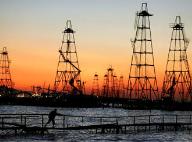 Unplanned interruptions in the global oil supply chain last year were about 30 percent higher than in 2013, the U.S. Energy Department said. Much of the problem was blamed on Libya, though sputtering from Kazakhstan's giant Kashagan field played a factor as well. This year could be North America's to lead in terms of secure production, but the story for 2014 is as certain as market predictions themselves.
Unplanned interruptions in the global oil supply chain last year were about 30 percent higher than in 2013, the U.S. Energy Department said. Much of the problem was blamed on Libya, though sputtering from Kazakhstan's giant Kashagan field played a factor as well. This year could be North America's to lead in terms of secure production, but the story for 2014 is as certain as market predictions themselves.
Outside of the cartel, last year's major breakthrough came when first production started from the giant Kashagan field off the Kazakh coast in the Caspian Sea. Lauded as one of the biggest oil developments this side of Texas, Kashagan ground to a halt about a month after production began because of pipeline leaks. EIA said that even if it gets going again, production from Phase 1 will be off the 370,000 bpd target because cost overruns and technical challenges.
For the U.S. Gulf of Mexico, EIA said it expected to see production grow by more than 20 percent from its 1.3 million bpd average in 2013 in the coming years. Its estimate, however, comes with a degree of uncertainty given the risks from extreme weather events in the region. Given the devastating winter in the United States this season, and historic flooding overseas, it's anybody's guess what future hurricanes will do to Gulf of Mexico production, which accounts for about a fifth of total U.S. output.
The story of the year, however, is shale. In its latest short-term market report, EIA said it expected oil production from onshore reserves in the Lower 48, including shale, will be 7.1 million bpd by 2015, nearly 25 percent more than last year. If drilling technological innovations continue to advance, EIA said, that production forecast may be vastly understated.
Already, EIA expects total U.S. oil production will increase to 9.2 million within the year. That's sparked a feeding frenzy not only for oil companies looking to capitalize on the growth but from analysts wondering if it's time to use that oil for "coercive political influence" overseas.
But there's more to the story. Kazakhstan President Nursultan Nazarbayev said Kashagan is ready to go this year. If Phase 2 goes better than Phase 1, operations from the offshore giant could double to 740,000 bpd. In its February market report, OPEC said Kazakhstan is "trying to drum up interest" in additional basins outside of Kashagan. For members of the cartel, meanwhile, OPEC said it was Libya that was making a comeback. And while Algeria's oil production was down, BP and its partners could be setting trends with their return to the country after last year's terrorist attacks. If Iran can keep the nuclear conversation going, meanwhile, its presence on the oil stage could make for a crowded market.
EIA cautioned that, with all predictions, the outlook for 2014 was uncertain. Naysayers say we're near the end of the North American shale story. OPEC, in its market report, said the crude oil production from the Bakken, Eagle Ford and Permian basins will continue their growth spurt in 2014, but at a slower rate than before. OPEC and other major producers were forced to re-adjust to last year's shale shift in production dynamics. The oil narrative for this year may be just like this season's weather ---extreme and highly unpredictable.
By Daniel J. Graeber from Oilprice.com




